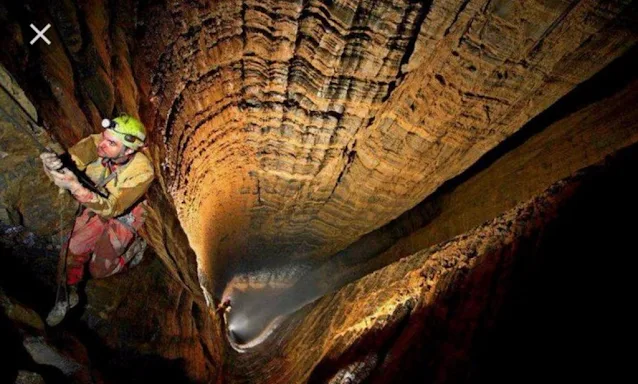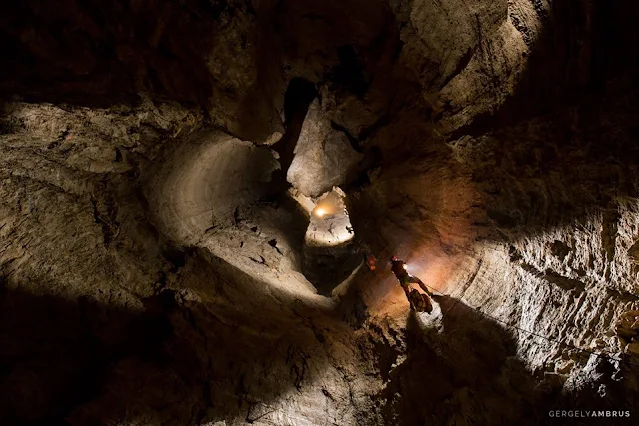The World’s Deepest Cave Known As ‘Everest Of The Caves’
 |
| Krubera-Voronya cave Georgie |
Voronya Cave, also known as Krubera Cave, The Deepest Cave In The World!
The cave, known as Krubera or Voronya, is considered the “Everest of the caves”. The total length of cave passages reaches 13,232 m, the depth is -2,197 ± 20 meters, making it the deepest known cave in the world. It is located in the Arabika Massif of the Western Caucasus, in the Gagra Range of the Abkhazia region.
The difference in elevation of the cave's entrance and its deepest explored point is 2,197 ± 20 metres (7,208 ± 66 ft). It became the deepest-known cave in the world in 2001 when the expedition of the Ukrainian Speleological Association reached a depth of 1,710 m (5,610 ft) which exceeded the depth of the previous deepest-known cave, Lamprechtsofen, in the Austrian Alps, by 80 metres (260 ft).
The entrance to Voronya Cave is situated at an elevation of about 2,240 meters above sea level, which means the cave actually goes below sea level at its deepest point.
The cave is characterized by vertical shafts, narrow passages, and large chambers. The conditions inside are extremely challenging, with cold temperatures, high humidity, and the need for specialized caving equipment like ropes, harnesses, and sometimes diving gear due to water-filled passages.
The cave was first explored in detail by a team of Ukrainian speleologists in the 1960s, but significant depth was only achieved in the late 20th and early 21st centuries. The record depth has been pushed deeper several times, with significant explorations in 2001, 2004, and 2012.
In 2004, for the first time in the history of speleology, the Ukrainian Speleological Association expedition reached a depth greater than 2,000 metres (6,600 ft), and explored the cave to −2,080 m (−6,824 ft).
In the 1960s, the cave was named after Russian geographer Alexander Kruber by Soviet speleologists who were exploring it. Later, in the 1980s, Kyiv speleologists referred to it as "Voronya Cave," meaning "Crows' Cave" in Russian, due to the crows that nested at the cave's entrance.
 |
The entrance to Voronya Cave, the world's deepest known cave. |
The Ortobalagan Valley extends along the crest of the Berchil'sky anticline, which gently dips northwest. The cave entrances are aligned along the anticlinal crest, but the caves are controlled by longitudinal, transverse, and oblique fractures and faults and comprise complex winding patterns in the plan view, remaining largely within and near the anticlinal crest zone.
The caves are predominantly combinations of vadose shafts and steep meandering passages, although in places they cut apparently old fossil passages at different levels (e.g., at −2,100–2,040 m (−6,890–6,690 ft) in Kujbyshevskaja and Krubera caves, −1,200–1,240 m (−3,940–4,070 ft) and −980–1,150 m (−3,220–3,770 ft) in the non-Kujbyshevskaja branch of Krubera Cave, etc.).
The deep parts of Krubera display a more pervasive conduit pattern with a mixture of phreatic morphology, characteristic of the zone of high-gradient floods, which can be up to 400 m above the low-flow water table, and vadose downcutting elements that are observed even below the water table.
The core part of the Arabika Massif is composed of the Upper Jurassic succession resting on the Bajocian Porphyritic Series, which includes sandstones, clays and conglomerates at the top, and tuff, tuff sandstones, conglomerates and breccia, porphyry and lava.
 |
| Inside the vast chambers of Voronya cave |
The Porphyritic series forms the non-karstic basement of Arabika, which is exposed only on the northern and eastern outskirts, locally in the bottoms of the Kutushara and Gega River valleys.
In the central part of Arabika the Cretaceous cover (Valanginian and Hauterivian limestones, marls and sandstones) is retained only in a few ridges and peaks, but it lies intact through the low-altitude ridges to the south-west of the central part. There the Cretaceous succession includes Barremian and Aptian–Cenomanian limestones and marly limestones with abundant concretions of black chert.
The Upper Jurassic succession begins with thin-bedded Kimmeridgian–Oxfordian cherty limestones, marls, sandstones and clays, which are identified in the lower part of Krubera Cave. Above lies the thick Tithonian succession of thick-bedded limestones with marly and sandy varieties. Sandy limestones are particularly abundant through the upper 1,000 m sections of deep caves of the Ortobalagan Valley.
 |
| A group of explorers rappelling down a narrow shaft in Voronya cave, the world's deepest cave |
Major on-shore karst springs with individual average discharges of 1 to 2.5 m3/s (35 to 88 cu ft/s) are located at altitudes ranging from 1 m (3.3 ft) (Reproa Spring) to 540 m (1,770 ft) (Gega waterfall). Two of them are located in the shore area; these are Reproa (average discharge 2.5 m3/s or 88 cu ft/s; altitude 1 m or 3 ft 3 in above sea level) and Kholodnaja Rechka (1.2 m3/s or 42 cu ft/s; 50 m or 160 ft a.s.l.).
Two more major springs are located in the river canyons bordering Arabika to the east: Goluboe Ozero in the Bzyb canyon (2.5 m3/s or 88 cu ft/s; 90 m or 300 ft a.s.l.) and Gega waterfall in the Gega canyon (1 m3/s or 35 cu ft/s; 540 m or 1,770 ft a.s.l.). There are also several smaller springs in the Gagra town. The Reprua River, one of the shortest rivers in the world, about 60 ft long, starts in the cave and flows toward the Black Sea.
Some boreholes located along the shore of the Black Sea yield karstic groundwater from depths of 40–280 m below sea level. Other much deeper boreholes tapped low-salinity karstic waters at depths of 500 and 1,750 m in the Khashupse Valley near Tsandripsh and 2,250 m near Gagra. This suggests the existence of a deep karst system and vigorous karst groundwater circulation at depth.
 |
| Krubera-Voronya cave Photo credit: Gergely Ambrus photography |
 |
| Climbers descending into Krubera-Voronya cave Photo credit: Gergely Ambrus photography |
 |
| Exploring the depths of Krubera or Voronya cave Photo credit: Gergely Ambrus photography |
The cave is very deep and complex, and it can be difficult to navigate. However, the rewards are great for those who are willing to take on the challenge. The cave is a beautiful and fascinating place, and it is a once-in-a-lifetime opportunity to explore the depths of the Earth.








